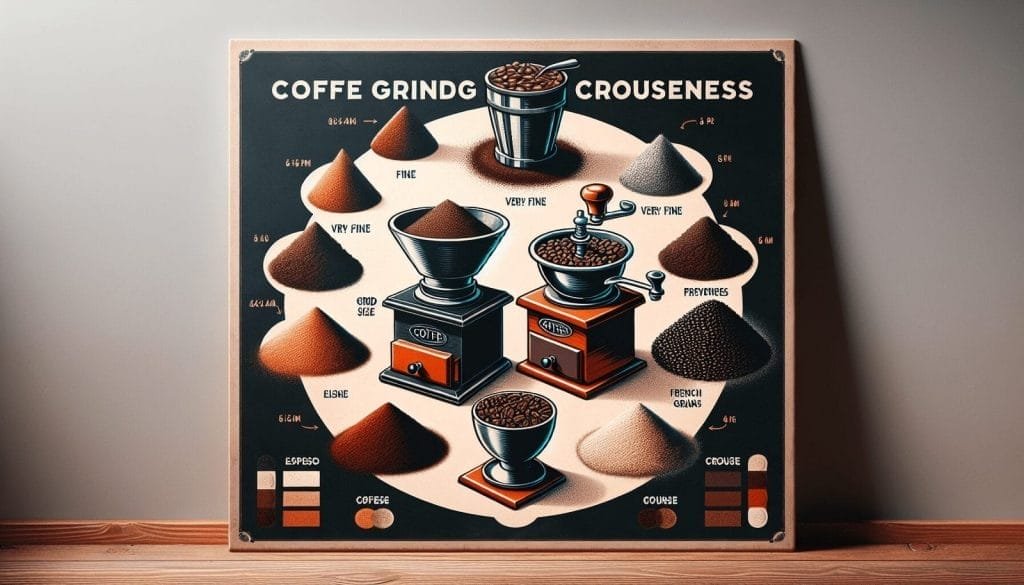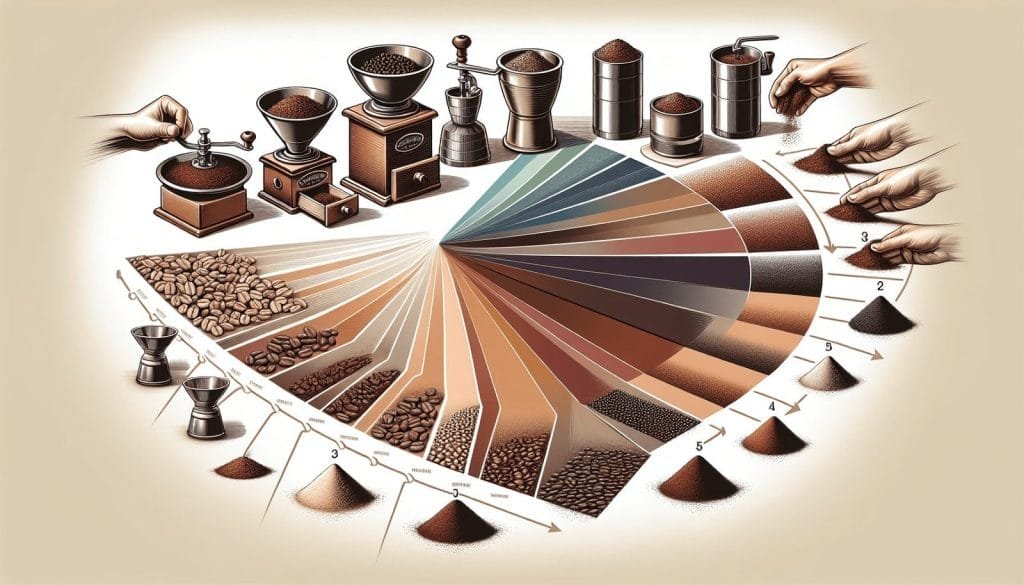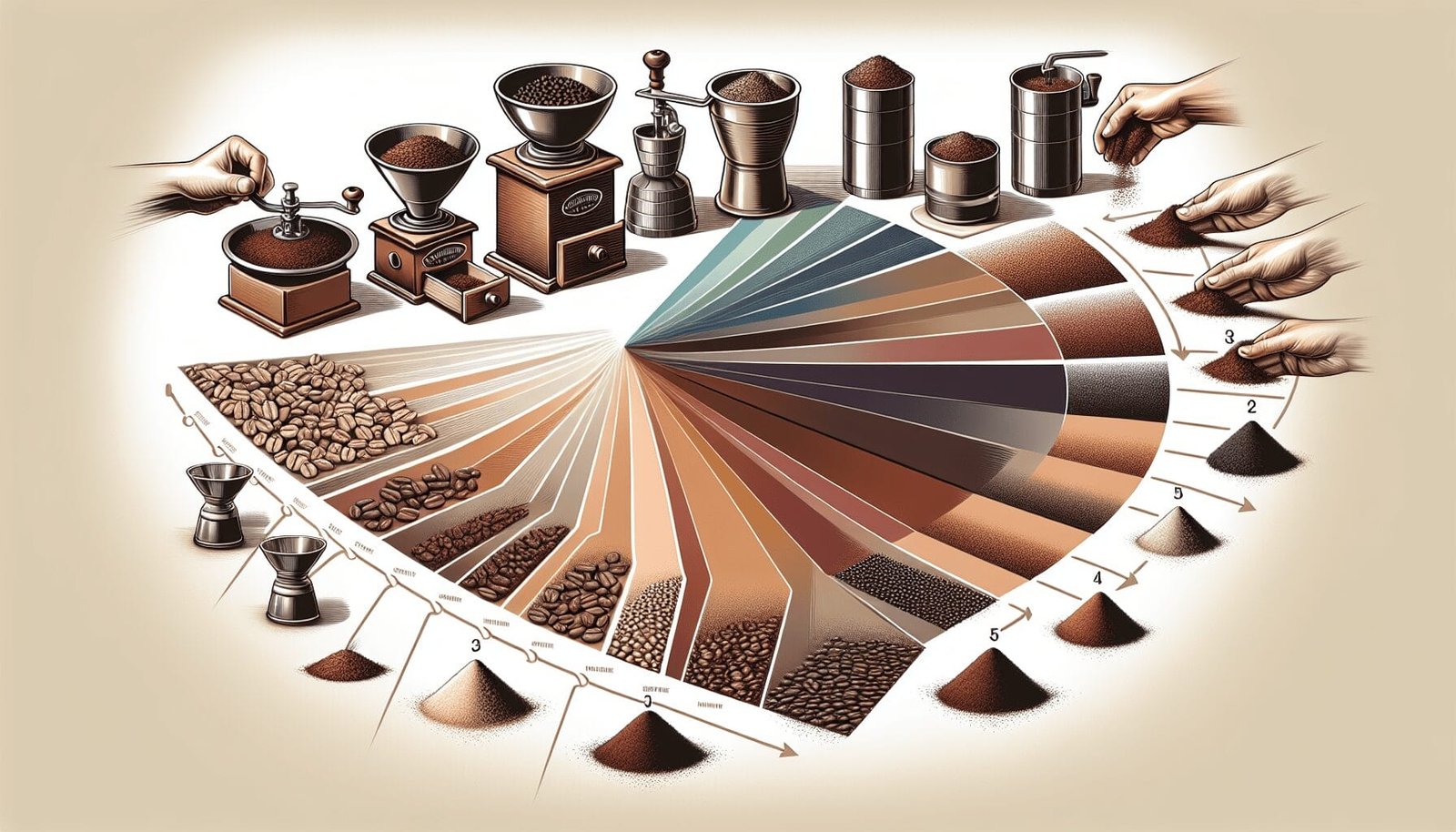So you’ve finally decided to start grinding your own coffee beans at home. Congrats! But before you get started, it’s important to understand the role of coffee grinding coarseness in brewing a perfect cup of joe. In this ultimate beginner’s guide, we’ll break down all the ins and outs of coffee grinding coarseness, from why it matters to how to achieve the ideal grind size for your preferred brewing method. So grab your favorite mug and get ready to elevate your coffee game to a whole new level.
Types of Coffee Grinders
Blade Grinders
Blade grinders are the most basic and budget-friendly type of coffee grinders. They consist of a spinning blade that chops the beans into smaller pieces. However, this type of grinder does not offer precise control over the grind size, resulting in an inconsistent grind. The blades can also create heat, which can affect the flavor of the coffee. Despite their limitations, blade grinders are suitable for beginners or those on a tight budget.
Burr Grinders
Burr grinders are considered the gold standard for coffee grinding. They use two revolving abrasive surfaces, known as burrs, to crush the beans into a consistent grind size. Burr grinders offer a wide range of grind size options, from fine to coarse, making them suitable for various brewing methods. They ensure a more even extraction and produce a uniform and flavorful cup of coffee. Burr grinders can be further divided into two types: conical burrs and flat burrs, each with its own advantages and disadvantages.
Manual Grinders
Manual grinders are a popular choice for coffee enthusiasts who prefer a more hands-on approach. These grinders require physical effort to grind the beans and often use burr grinding mechanisms. Manual grinders offer excellent control over the grind size and are especially useful for portable use or in situations where electricity is not available. While they may require more time and effort, manual grinders can deliver exceptional results in terms of grind consistency.
Understanding Coffee Grinding Coarseness
Why Coarseness Matters
The coarseness of the coffee grind plays a crucial role in determining the flavor and extraction of your coffee. Different brewing methods require specific grind sizes to achieve the desired taste profile. Grinding coffee too fine or too coarse can result in under-extraction or over-extraction, leading to a bland or overly bitter cup of coffee. By understanding the importance of coarseness, you can enhance your brewing experience and customize your coffee to suit your preferences.
Factors Affecting Coarseness
Several factors influence the coarseness of the coffee grind. The main factors include the brewing method, the type of coffee roasting, and personal taste preferences. Some brewing methods, such as espresso, require a fine grind, while others, like French press, call for a coarse grind. The coffee roast level also affects the coarseness, as lighter roasts generally require a finer grind compared to darker roasts. Exploring these factors will help you determine the ideal coarseness for your desired cup of coffee.
Common Coarseness Levels
Coffee grinds can be categorized into several common coarseness levels, ranging from extra coarse to extra fine. The coarseness level determines the size of the coffee particles and directly impacts the extraction process. Extra coarse is typically used for cold brew or some types of infusion methods, while medium-coarse is suitable for a pour-over or Chemex brewing. Medium grinds work well for drip coffee machines, while medium-fine grinds are ideal for cone-shaped pour-overs. Finally, espresso and Turkish coffee require a fine or extra fine grind.

Grind Size Recommendations for Different Brewing Methods
French Press
French press brewing requires a coarse grind to allow for a longer extraction time. The large coffee particles help prevent over-extraction and produce a rich and full-bodied cup of coffee. A consistent grind size in the range of medium-coarse to coarse is recommended for this method.
Pour Over
Pour over methods, such as the Hario V60 or Chemex, benefit from a medium-coarse grind. This grind size allows for a balanced extraction, producing a clean and vibrant cup of coffee. The pour over process relies on gravity to extract the flavors from the coffee, and a consistent grind ensures an even extraction.
Espresso
Espresso brewing demands a fine grind to maximize the extraction of flavors in a short amount of time. The fine grind size allows for high-pressure water to pass through the coffee quickly, resulting in a concentrated and intense shot. Consistency and precision are essential when grinding for espresso to achieve optimal flavor extraction.
Siphon/Vacuum Pot
Siphon or vacuum pot brewing involves a unique process of water and coffee interacting in a sealed chamber. For this method, a medium grind size is recommended to strike a balance between extraction and clarity. The medium grind allows for a thorough extraction while avoiding excessive sediment in the final cup.
Aeropress
The Aeropress brewing method offers versatility and allows for experimentation with grind size. However, a medium-fine grind is generally recommended to produce a flavorful and well-extracted cup of coffee. The pressure used in the Aeropress allows for a shorter brew time, making a slightly finer grind desirable.
Moka Pot
Moka pot brewing, popularized by Italian coffee culture, requires a fine grind to achieve the desired flavor concentration. The pressure created by steam passing through the coffee grounds demands a consistent and fine grind size. This produces a strong and robust cup of coffee reminiscent of espresso.
Cold Brew
Cold brew coffee relies on time rather than heat to extract flavors from the coffee. Due to the extended steeping period, a coarse grind is recommended. This coarse grind helps prevent over-extraction and results in a smooth, low-acidity coffee concentrate ideal for iced coffee or refreshing summer beverages.
How to Choose the Right Coarseness
Personal Taste and Preference
Choosing the right coarseness level for your coffee grounds ultimately comes down to personal taste and preference. Experimenting with different grind sizes allows you to discover the flavors and characteristics that align with your palate. Some individuals may prefer a strong and bold cup of coffee, while others may enjoy a smoother and milder taste. Adjusting the coarseness level will help you achieve the desired flavor profile.
Brewing Method
The brewing method you use heavily influences the coarseness of the grind. Different brewing methods require specific grind sizes to extract the optimal flavors from the coffee. Understanding the requirements of your chosen brewing method empowers you to make an informed decision when selecting the appropriate coarseness for your coffee.
Coffee Roast Level
The roast level of your coffee beans also affects the coarseness of the grind. Lighter roasts tend to be denser and require a finer grind to fully extract their delicate flavors. On the other hand, darker roasts are more porous and may require a coarser grind to avoid over-extraction. Considering the roast level when choosing the coarseness ensures that you achieve a well-balanced and flavorful cup of coffee.
Experimentation and Adjustments
Finding the perfect coarseness for your coffee may involve some trial and error. Experimentation is key to discovering your preferred grind size. Start with the recommended grind sizes for your brewing method and adjust from there based on taste and extraction results. Keep notes on your brewing process and the grind size used to replicate or adjust your brew in the future.

The Importance of Consistency
Consistency in Extraction
Consistency in the grind size plays a crucial role in the extraction of flavors from your coffee. A consistent grind ensures that all coffee particles are exposed to the same amount of water during brewing, leading to a uniform extraction. Inconsistent grind sizes can cause over-extraction of finer particles and under-extraction of coarser particles, resulting in an imbalanced and uneven cup of coffee.
Consistency in Brewing
Consistency in the brewing process goes hand in hand with grind size consistency. By maintaining a consistent grind each time you brew, you can eliminate one variable that may impact the quality and taste of your coffee. This consistency allows you to dial in on your preferred brewing parameters and create a consistently delicious cup of coffee.
Grinding Coarseness and Extraction Time
Under-Extraction
Under-extraction occurs when coffee grounds are not exposed to water for a sufficient amount of time, resulting in an unbalanced and weak cup of coffee. This can happen when the grind size is too coarse, and water passes through the coffee too quickly. Adjusting the grind size to a finer setting allows for increased extraction and a more flavorful brew.
Over-Extraction
Over-extraction occurs when coffee grounds are exposed to water for too long, resulting in a bitter and astringent taste. This can happen when the grind size is too fine, causing the water to interact with the coffee for an extended period. Adjusting the grind size to a coarser setting reduces the extraction time and helps prevent over-extraction.
Ideal Extraction Time
The ideal extraction time varies based on the brewing method and personal preference. By experimenting with different coarseness levels and extraction times, you can find the sweet spot for your desired cup of coffee. Achieving a balance between extraction and flavor is key to producing a well-rounded and enjoyable brew.
Methods for Achieving the Desired Coarseness
Grinder Settings
Most coffee grinders offer adjustable settings to control the coarseness of the grind. By selecting the appropriate setting on your grinder, you can achieve the desired grind size for your brewing method. Refer to the user manual or manufacturer’s guidelines to understand how to adjust the settings on your specific grinder model.
Time-based Grinding
For grinders without adjustable settings, you can control the coarseness by adjusting the grinding time. Longer grinding times produce finer grounds, while shorter grinding times result in coarser grounds. This method requires some trial and error to determine the optimum grinding time for your desired coarseness.
Visual Inspection
Visual inspection is a simple yet effective method of assessing the coarseness of your coffee grounds. After grinding, examine the size and consistency of the particles. Coarser grounds will resemble sea salt, while finer grounds will resemble powdered sugar. Adjust the grind time or settings accordingly based on your visual assessment.
Common Mistakes to Avoid
Inconsistent Grinding
One common mistake when grinding coffee is inconsistent grinding. Inconsistency can lead to uneven extraction and ultimately affect the flavor of your coffee. Ensure that your grinder is properly calibrated and well-maintained to achieve consistent and uniform grind sizes.
Wrong Coarseness Level for Brewing Method
Using the wrong coarseness level for your brewing method can lead to undesirable results. Make sure to research and understand the recommended grind size for your chosen brewing method. Experimentation and adjustments may be necessary to achieve the best possible flavor extraction.
Not Adjusting for Different Beans
Different coffee beans can have varied densities and characteristics that may require adjustments in the coarseness of the grind. Take into consideration the origin, roast level, and bean variety when determining the appropriate grind size. Adapting to different beans allows you to fully appreciate their unique flavors.
Maintenance and Cleaning of Coffee Grinders
Regular Cleaning
Regular cleaning of your coffee grinder is essential to maintain the quality of your coffee and prevent the buildup of oils and residue. Follow the manufacturer’s instructions for cleaning and removing coffee grounds, ensuring that all components are thoroughly cleaned and dried before use.
Deep Cleaning
Periodically, it is necessary to perform a deep cleaning of your coffee grinder to remove any stubborn residue. This involves disassembling the grinder and cleaning each component individually. Use a brush or toothpick to remove any stuck grounds or particles in hard-to-reach areas. Refer to your grinder’s manual or online resources for detailed instructions on performing a deep clean.
Burr Alignment
For burr grinders, proper burr alignment is crucial for consistent and precise grinding. Over time, burrs may become misaligned, affecting the grind quality. Consult your grinder’s manual for instructions on adjusting or aligning the burrs. Regularly checking and realigning the burrs will ensure optimal grind consistency.
Resources for Further Learning
Books on Coffee
Expand your knowledge on coffee and the art of brewing by exploring coffee-related books. There are numerous books available that cover various aspects of coffee, from history and origins to brewing techniques and flavor profiles. Some popular titles include “The World Atlas of Coffee” by James Hoffman and “Coffee Obsession” by Anette Moldvaer. These books are great resources for diving deeper into the world of coffee.
Online Coffee Communities
Engaging with online coffee communities can provide valuable insights and tips from fellow coffee enthusiasts. Platforms such as Reddit’s r/coffee or specialty coffee forums offer opportunities to discuss brewing techniques, ask questions, and receive advice from experienced coffee lovers. Online communities provide a space to connect with like-minded individuals and share in the passion for coffee.
Coffee Brewing Classes
Consider attending coffee brewing classes or workshops to further enhance your understanding of coffee grinding coarseness and brewing techniques. Many coffee shops, roasteries, and specialty cafes offer classes led by skilled baristas or coffee experts. These classes provide hands-on experience, expert guidance, and a deeper appreciation for the intricacies of coffee brewing.
By familiarizing yourself with the various types of coffee grinders, understanding the importance of coarseness, and learning how to choose the right coarseness for different brewing methods, you can elevate your coffee brewing skills to new heights. Remember to prioritize consistency, avoid common mistakes, and properly maintain your coffee grinder for optimal results. With practice and experimentation, you’ll be able to create the perfect cup of coffee tailored to your personal taste. Happy brewing!




